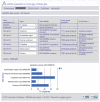Mining Gene Ontology Data with AGENDA
- PMID: 22553422
- PMCID: PMC3337784
- DOI: 10.4137/BBI.S9101
Mining Gene Ontology Data with AGENDA
Abstract
The Gene Ontology (GO) initiative is a collaborative effort that uses controlled vocabularies for annotating genetic information. We here present AGENDA (Application for mining Gene Ontology Data), a novel web-based tool for accessing the GO database. AGENDA allows the user to simultaneously retrieve and compare gene lists linked to different GO terms in diverse species using batch queries, facilitating comparative approaches to genetic information. The web-based application offers diverse search options and allows the user to bookmark, visualize, and download the results. AGENDA is an open source web-based application that is freely available for non-commercial use at the project homepage. URL: http://sourceforge.net/projects/bioagenda.
Keywords: Gene Ontology; complex query; controlled vocabulary; data mining; gene annotation.
Figures

Similar articles
-
The Gene Ontology (GO) project in 2006.Nucleic Acids Res. 2006 Jan 1;34(Database issue):D322-6. doi: 10.1093/nar/gkj021. Nucleic Acids Res. 2006. PMID: 16381878 Free PMC article.
-
WEGO: a web tool for plotting GO annotations.Nucleic Acids Res. 2006 Jul 1;34(Web Server issue):W293-7. doi: 10.1093/nar/gkl031. Nucleic Acids Res. 2006. PMID: 16845012 Free PMC article.
-
DynGO: a tool for visualizing and mining of Gene Ontology and its associations.BMC Bioinformatics. 2005 Aug 9;6:201. doi: 10.1186/1471-2105-6-201. BMC Bioinformatics. 2005. PMID: 16091147 Free PMC article.
-
Applying the Gene Ontology in microbial annotation.Trends Microbiol. 2009 Jul;17(7):262-8. doi: 10.1016/j.tim.2009.04.003. Epub 2009 Jul 2. Trends Microbiol. 2009. PMID: 19577473 Review.
-
Gene Ontology annotation of the rice blast fungus, Magnaporthe oryzae.BMC Microbiol. 2009 Feb 19;9 Suppl 1(Suppl 1):S8. doi: 10.1186/1471-2180-9-S1-S8. BMC Microbiol. 2009. PMID: 19278556 Free PMC article. Review.
References
-
- Kumar S, Dudley J. Bioinformatics software for biologists in the genomics era. Bioinformatics. 2007;23(14):1713–7. - PubMed
-
- Baxevanis AD. The importance of biological databases in biological discovery. Curr Protoc Bioinformatics. 2009;Chapter 1(Unit 1):1. - PubMed
-
- Bard JB, Rhee SY. Ontologies in biology: design, applications and future challenges. Nature Reviews Genetics. 2004;5(3):213–22. - PubMed
LinkOut - more resources
Full Text Sources

